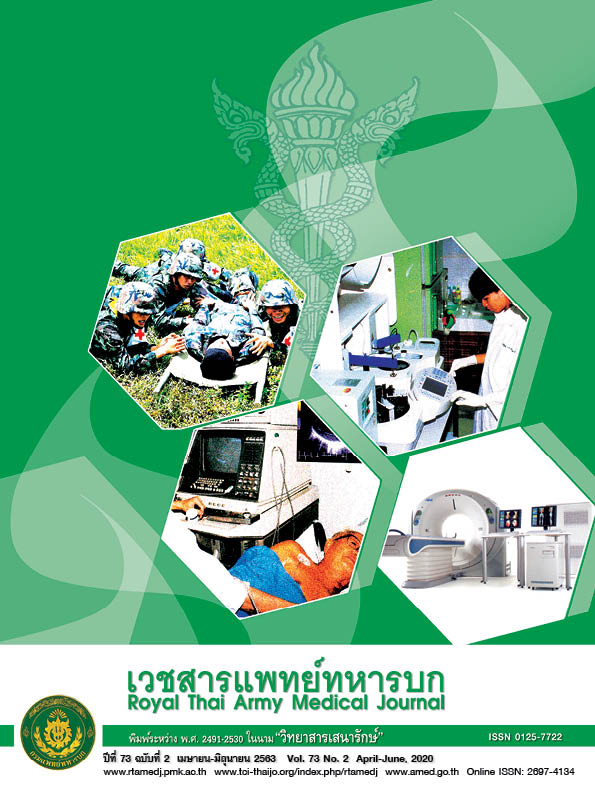Computed tomographic findings in heat stroke patients: A retrospective review at Phramongkutklao Hospital between 2002-2017
Main Article Content
Abstract
Introduction: Incidences of heat stoke are increasing over time. Early diagnosis and prompt management are crucial for the survival of patients. Magnetic resonance imaging could help in diagnosis and prognosis. However, due to limited resources and unstable status of patients, Computed Tomography (CT scan) may be used for evaluation instead.
Purpose: To study various findings of the computed tomography in heatstroke patients and the percentage of occurrences at Phramongkutklao Hospital.
Material and methods: This research was conducted as a retrospective descriptive study. The computed tomography of heatstroke patients (ICD-10 = T67.0) performed during 2002-2017 was retrospectively reviewed. The data was collected through the picture archiving and communicating system (PACS) and medical records at Phramongkutklao Hospital.
Result: A total of 128 patients were diagnosed with heatstroke between January 1, 2002 and December 31, 2017. Only 19 patients were examined by CT scan. The mortality rate of this group was 10.5%. Six of 19 had abnormality found on the CT scan, however, it was not correlated with the treatment outcome. The neurological deficits found among 80% of the survivors with partial recovery were cerebellar ataxia. The level of consciousness as shown in GCS did not seem to correlate with the treatment outcome either.
Conclusion: Most neurological deficits of the survivors occurred at cerebellum. The CT scan was not sensitive enough to detect abnormality and show correlation with the treatment outcome. In the future, we should use MRI scan instead of CT scan even for patients with low Glasgow coma score because of high sensitivity of MRI to detect abnormality of cerebellum.
Downloads
Article Details
Articles in this journal are copyrighted by the Royal Thai Army Medical Department and published under the Creative Commons Attribution-NonCommercial-NoDerivatives 4.0 International (CC BY-NC-ND 4.0) license.
may be read and used for academic purposes, such as teaching, research, or citation, with proper credit given to the author and the journal.
Use or modification of the articles is prohibited without permission.
Statements expressed in the articles are solely the opinions of the authors.
Authors are fully responsible for the content and accuracy of their articles.
Any other republication of the articles requires permission from the journal.
References
2. Sithinamsuwan P , Piyavechviratuna K , KitthaweesinT, Chusri W, OrrawanhanothaiP, Wongsa A, et al. Exertional heatstroke: early recognition and outcome with aggressive combined cooling-a 12- year experience. Mil Med. 2009;174(5):496-502.
3. DeGroot DW, Mok G, Hathaway NE. International Classification of Disease Coding of Exertional Heat Illness in U.S. Army Soldiers. Mil Med. 2017 Sep;182(9):e1946-e1950.
4. Lee JS, Choi JC, Kang SY, Kang JH, Park JK. Heat stroke: increased signal intensity in the bilateral cerebellar dentate nuclei and splenium on diffusion-weighted MR imaging. AJNR Am J Neuroradiol. 2009; 30(4): E58.
5. Albukrek D, Bakon M, Moran DS, Faibel M, Epstein Y. Heat-stroke-induced cerebellar atrophy: clinical course, CT and MRI findings. Neuroradiology. 1997; 39(3): 195-7.
6. Murcia-Gubianas C, Valls-Masot L, Rognoni-AMRIein G. Brain magnetic resonance imaging in heat stroke. Med Intensiva. 2012; 36(7): 526.
7. Mahajan S, Schucany WG. Symmetric bilateral caudate, hippocampal, cerebellar, and subcortical white matter MRI abnormalities in an adult patient with heat stroke. Proc (Bayl Univ Med Cent). 2008; 21(4): 433-6.
8. Ookura R, Shiro Y, Takai T, Okamoto M, Ogata M. Diffusion-weighted magnetic resonance imaging of a severe heat stroke patient complicated with severe cerebellar ataxia. Intern Med. 2009; 48(12): 1105–8.
9. Sudhakar PJ, Al-Hashimi H. Bilateral hippocampal hyperintensities: a new finding in MR imaging of heat stroke. Pediatr Radiol. 2007; 37(12): 1289-91.
10. Prasun P, Karmarkar SA, Agarwal A, Stockton DW. Unusual physical features and heat stroke presentation for hypohydrotic ectodermal dysplasia. Clin Dysmorphol. 2012; 21(1): 24-6.
11. Szold O, Reider-Groswasser II, Ben Abraham R, Aviram G, Segev Y, Biderman P, et al. Gray-white matter discrimination--a possible marker for brain damage in heat stroke? Eur J Radiol. 2002;43(1):1-5.
12. Argaud L, Ferry T, Le QH, Marfisi A, Ciorba D, Achache P, et al. Short- and long-term outcomes of heatstroke following the 2003 heat wave in Lyon, France. Arch Intern Med. 2007;167(20):2177-83.
13. Yang M, Li Z, Zhao Y, Zhou F, Zhang Y, Gao J, et al. Outcome and risk factors associated with extent of central nervous system injury due to exertional heat stroke. Medicine (Baltimore). 2017;96(44):e8417.
14. Bazille C, Megarbane B, Bensimhon D, Lavergne-Slove A, Baglin AC, Loirat P, et al. Brain damage after heat stroke. J Neuropathol Exp Neurol. 2005;64(11):970–5.
15. Liu ZF, Li BL, Tong HS, Tang YQ, Xu QL, Guo JQ, et al. Pathological changes in the lung and brain of mice during heat stress and cooling treatment. World J Emerg Med. 2011;2(1):50-3.


